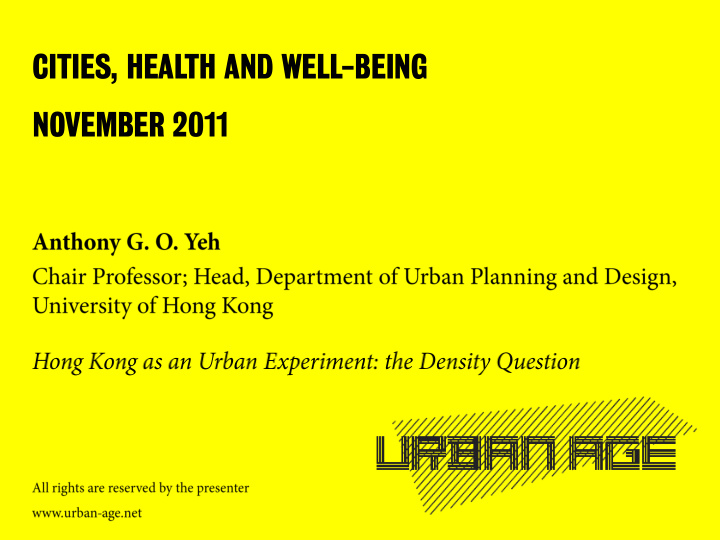



CITIES, HEALTH AND WELL-BEING NOVEMBER 2011
Hong Kong as an Urban Experiment The Density Question Anthony Yeh Centre of Urban Studies and Urban Planning Department of Urban Planning and Design The University of Hong Kong
Why is Density Important ? • Increase in urban population, especially in China • Trend in Compact Development The University of Hong Kong
High Density Development • Advantages : – Save land, environment, and infrastructure costs – Shorten travel distance, save transport energy – Support mass transit system, low carbon city The University of Hong Kong
Newman, P. and Kenworthy, J. (1989). Cities and Automobile Dependence: A Sourcebook. Victoria: Gower, Aldershot and Brookfield.
The University of Hong Kong
Density of Hong Kong • Land Area 1,100 sq km • Population 7.10 million • Overall Density 6,400 persons/sq km • Urban Area Density 20,700 persons/sq km • Mong Kok’s Density 110,000 persons/sq km • Street Block Density 400- 600,000 persons/sq km The University of Hong Kong
High Density Development • Advantages : – Save land, environment, and infrastructure costs – Shorten travel distance, save transport energy – Support mass transit system, low carbon city • Disadvantages : – Crowding – Social pathology The University of Hong Kong
High Density and Crowding • No direct relationship between social pathology and high density • Crowding is a psychological feeling • Chinese culture can tolerate high density The University of Hong Kong
Man and the Urban Environment COMMUNITY FACILITIES AND MANAGEMENT DESIGN AND AESTHETIC ENVIRONMENT Community Facilities Layout Community Facilities Layout Community Facilities Layout Layout Community Facilities Community Facilities Layout Design Management Degree of Sharing Design socio- economic background age culture ROOM FLAT BUILDING Open Space STREET BLOCK Traffic Traffic NEIGHBOURHOOD Open Space Open Space Traffic DISTRICT CITY Open Space Traffic Open Space Traffic SOCIO-ECONOMIC ENVIRONMENT OPEN SPACE TRAFFIC
Feeling of Crowdiness • Design and layout of buildings and sites • Traffic and movement • Clean and well managed living and working environment • Cultural and socio-economic background and habit of a person • HK has been quite successful in reducing the feeling of crowdiness through good planning, design and management The University of Hong Kong
High Density ? The University of Hong Kong
High Density ? The University of Hong Kong
Building Density Low Rise Building Tall Building High Building Density Low Building Density Less Extended Space More Extended Space
Comparison between Respondents’ Perception on Building Heights between Hong Kong and Singapore 100 Singapore: Not Tall 90 HK: Not Tall Singapore: very Tall HK: Very Tall 80 70 60 50 40 30 20 Singapore: Tall HK: 10 0 10-storey 15-storey 20-storey 25-storey 30-storey 40-storey 50-storey 60-storey
The University of Hong Kong
Some Measures in Hong Kong in Reducing Crowdiness The University of Hong Kong
The University of Hong Kong
The University of Hong Kong
The University of Hong Kong
The University of Hong Kong
The University of Hong Kong
Converting Private Space into Public Space
The University of Hong Kong
The University of Hong Kong
Housing Management and Public Education The University of Hong Kong
Wall Effect • Air Ventilation • Heat Island Air Ventilation Assessment • Air Quality and Pollution • Sun Light
The University of Hong Kong
The University of Hong Kong
The University of Hong Kong
Planning, Design and Management of High Density Living • High density living environment is more demanding than low density living environment • A small planning and management error will affect a lot of people • Good urban environment cannot totally rely on good planning – it needs good management • Better planning, design, and management can reduce the negative impacts of high density living The University of Hong Kong
Thank You Anthony Yeh Centre of Urban Studies and Urban Planning Department of Urban Planning and Design 2011 The University of Hong Kong
Recommend
More recommend